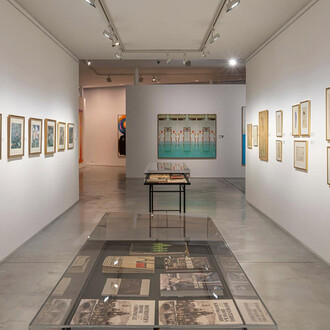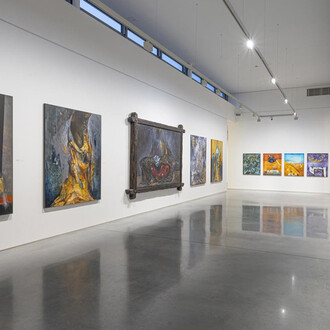Hermann Nitsch was known for his interdisciplinary practice that encompassed performance, painting, musical composition, and more. Having trained at Vienna’s Graphische Lehr- und Versuchsanstalt in the 1950s, the artist became a pioneer of the city’s avant-garde scene in the 60s and 70s, staging radical and controversial performances as part of the Viennese Actionism movement. He conceived his famed Orgies Mysteries Theatre in the 50s, and the expansive, sensorial performance was realized as the 6-Day-Play. In the early years of his painting practice, Nitsch created Action paintings by splattering paint onto canvases. Additionally, Nitsch created graphic prints that examine the labyrinthine makeup of the human body, which he described as “the architecture of the O.M. Theatre.
During the 90s, Nitsch began adding paint and blood splashes to his printing process, establishing a dialogue with his works on canvas. A standard monographic work of almost 1000 pages, “Hermann Nitsch – Das Gesamtkunstwerk des Orgien Mysterien Theaters”, testifies to the immense activity and relevance of his person. Recently, Nitsch has increasingly devoted himself to the theme of resurrection in his painting and was most recently able to realize a painting action at the Wagner Festival 2021 in Bayreuth by invitation. His works are exhibited in the two monographic museums in Mistelbach and Naples as well as in the Nitsch Foundation in Vienna and in prestigious international museums and galleries. Hermann Nitsch passed away on April 18, 2022.
Hermann Nitsch (1938 – 2022):
- 1957-develops the idea of the orgien mysterien theatre, a six-day festival whose concept is based on the artist’s main philosophy and that has been developing till today. The o.m. theatre is a new form of a total work of art where reality is staged and all five senses of the participants are engaged.
- 1962, 1st “action” in Vienna.
- 1972-participates at documenta 5, in Kassel, curated by Harald Szeemann;
first 12-hour action (40th action) at the Mercer Art Center in New York.
Countless exhibitions in prestigious institutions worldwide from the 1960s to the present.















